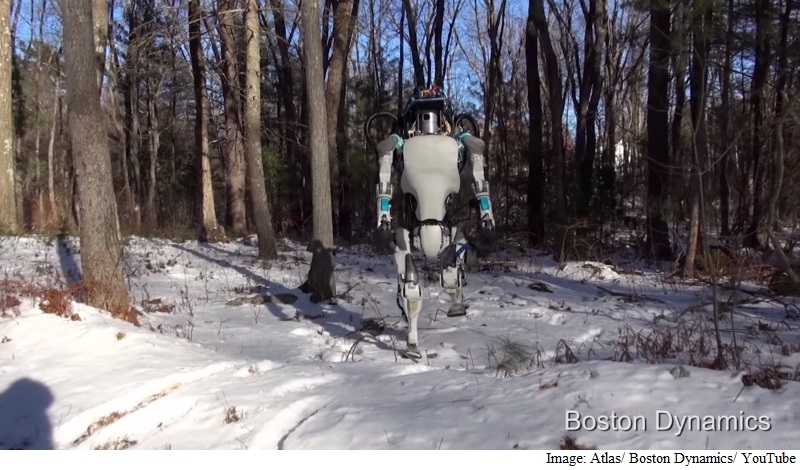- Home
- Science
- Science Features
- Why Roboticists Are Raving About Google's New Robot
Why Roboticists Are Raving About Google's New Robot

"They've set a new bar," said Aaron Ames, a Georgia Tech robotics professor. "It's a huge step towards getting robots that can actually operate in our world in unstructured environments on uneven terrain."
While plenty of two-legged robots can walk, none has been able to navigate uneven, unpredictable terrain.
There are no immediate applications for the average consumer, but robotics experts say the new version of Atlas is a building block toward robots that prepare our meals, fold our laundry and care for the elderly.
"That robot is out of the lab, outdoors, with no wires. It slips, but doesn't fall down," said Carnegie Mellon roboticist Chris Atkeson. "We're turning a corner in making robots better. The great unknown is when are we going to build hands and robot skin that is useful?"
Aside from the human-like ability to walk in the video, the 5-foot-9, 180-pound Atlas also places boxes on shelves, opens doors and gets back up after being knocked to the ground. Such a broad range of capabilities hasn't been seen before in one robot.
As is common in Boston Dynamics's videos, an employee plays rough with the robot to demonstrate the machine's abilities. In one scene an employee intentionally knocks Atlas to the ground. That would be unheard of previously, given that the robot is believed to cost in the hundreds of thousands. Previous versions of Atlas had ropes attached at all times to protect it from falls.
But the new Atlas has a sturdy roll cage. After being knocked to the ground, the robot gathered itself and stood back up. That ability most impressed Jerry Pratt, a senior research scientist at the Institute for Human & Machine Cognition.
"Robots are going to fall, there's no doubt about it," said Pratt, who previously competed in the DARPA Robotics Challenge with an earlier version of Atlas. Operators in the competition had to be overly cautions because of the high prices of falls.
Like Atkeson, Pratt believes the next frontier is figuring out hands and skin for robots, so they can better feel their surroundings, and interact with them. That would make it possible to do things such as chop vegetables, squeeze through tight spaces, or work in a nuclear plant that's melting down.
© 2016 The Washington Post
Catch the latest from the Consumer Electronics Show on Gadgets 360, at our CES 2026 hub.
Related Stories
- Samsung Galaxy Unpacked 2025
- ChatGPT
- Redmi Note 14 Pro+
- iPhone 16
- Apple Vision Pro
- Oneplus 12
- OnePlus Nord CE 3 Lite 5G
- iPhone 13
- Xiaomi 14 Pro
- Oppo Find N3
- Tecno Spark Go (2023)
- Realme V30
- Best Phones Under 25000
- Samsung Galaxy S24 Series
- Cryptocurrency
- iQoo 12
- Samsung Galaxy S24 Ultra
- Giottus
- Samsung Galaxy Z Flip 5
- Apple 'Scary Fast'
- Housefull 5
- GoPro Hero 12 Black Review
- Invincible Season 2
- JioGlass
- HD Ready TV
- Laptop Under 50000
- Smartwatch Under 10000
- Latest Mobile Phones
- Compare Phones
- OPPO A6 Pro 5G
- OPPO A6s
- OPPO Reno 15 Pro Max
- Honor Win RT
- Honor Win
- Xiaomi 17 Ultra Leica Edition
- Xiaomi 17 Ultra
- Huawei Nova 15
- Asus ProArt P16
- MacBook Pro 14-inch (M5, 2025)
- OPPO Pad Air 5
- Huawei MatePad 11.5 (2026)
- Xiaomi Watch 5
- Huawei Watch 10th Anniversary Edition
- Acerpure Nitro Z Series 100-inch QLED TV
- Samsung 43 Inch LED Ultra HD (4K) Smart TV (UA43UE81AFULXL)
- Asus ROG Ally
- Nintendo Switch Lite
- Haier 1.6 Ton 5 Star Inverter Split AC (HSU19G-MZAID5BN-INV)
- Haier 1.6 Ton 5 Star Inverter Split AC (HSU19G-MZAIM5BN-INV)

















